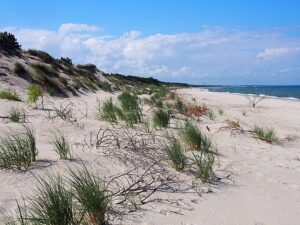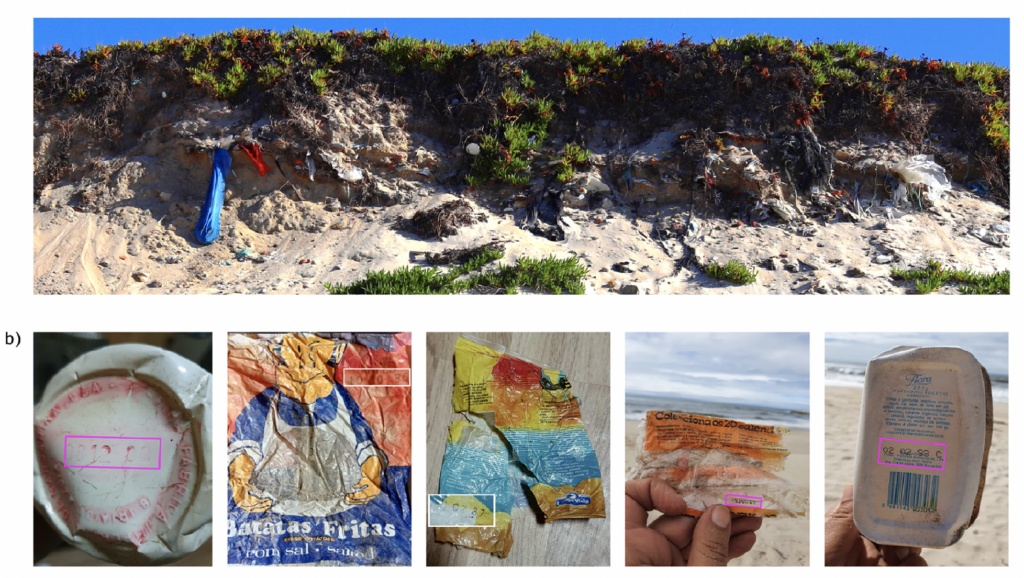Citation: Andriolo, U. and Gonçalves, G., 2022, Is coastal erosion a source of marine litter pollution? Evidence of coastal dunes being a reservoir of plastics: Marine Pollution Bulletin 174, 113307. doi: j.marpolbul.2021.113307
Several studies have shown that coastal dunes, which are present along many of the world’s coastlines, likely contain accumulations of litter from the last couple of decades. As these dunes are eroded, the enclosed litter is also freed, which could result in a large amount of litter being introduced into the marine environment. One way to try and prevent this re-introduction of anthropogenic waste into the natural environment is by monitoring coastal dune erosion.
What Are Coastal Dunes and How Do They Form?
Coastal dunes are accumulations of sand that run parallel to the shore. These landforms act as natural barriers that protect delicate coastal ecosystems and communities from environmental hazards, such as strong winds, wave activity, and flooding during high tide and storms. There are several types of dunes, which are largely differentiated based on their shapes or development stages.

Two types of dunes commonly found within coastal areas are foredunes and incipient or embryo dunes. Foredunes are located on the landward side of the beach and form as a result of the continuous accumulation of wind-blown sand. The sand is transported across the beach and then trapped and stabilized by vegetation that can tolerate being buried, accumulating to form the protective sand ridges. However, during large storms, the seaward facing side of these landforms, known as the dune face, can be eroded, which can cause the foredune to retreat further inland.
Incipient or embryo dunes, on the other hand, are located below foredunes at the top of the beach profile. These features form as a result of the entrapment of wind-blown sand by low vegetation and are exposed to both high tide and wave activity. Depending on the amount of sediment and type of vegetation present, the incipient dunes are either fully eroded or become the seaward edge of future foredunes.
How Do Coastal Dunes Relate to Marine Litter?
As coastal dunes are formed by the accumulation of wind-blown sand, these mounds can also incorporate wind-blown litter. This waste, which is left intentionally or unintentionally along the coast or is transported by wave activity from the sea, is moved across the beach by wind and waves and eventually becomes trapped by the dune vegetation. This entrapment frequently results in the burial of the litter by sand as the dune continues to build. However, once a dune face is eroded, this trapped waste is released back into the natural environment once again. From here, the litter can be carried into the sea, where it negatively impacts water quality and poses a major risk to local wildlife and marine life who can become entangled in the waste or mistake it for food.
How Can We Monitor Coastal Dune Litter?
In their study, Andriolo and Gonçalves analyzed the connection between dune formation and erosion and litter along two beaches in Portugal. They used a drone and a free mobile litter tracking app to identify and monitor litter that was included in an 11 meter high dune ridge at Leirosa Beach and in mobile incipient dunes and a 12 meter high foredune at Quiaios Beach. Through these non-invasive surveys, Adriolo and Gonçalves were able to assess the litter items present in the dunes and identify litter hotspots on their surfaces without disturbing the natural environment. In addition, the authors were able to assess the relationship between the dune vegetation and which types of litter items became trapped. By monitoring these areas over the course of nearly a year, the authors determined that larger concentrations of litter were exposed on the northern sections of the dunes, which coincided with the areas that were more prone to coastal erosion. They also found that the amount of recreation-related litter, such as plastic bottles and paper napkins, increased landwards and were largely included in foredunes, while the more seaward incipient dunes contained higher concentrations of fishing-related debris. However, these re-exposed litter were not only modern in date and were instead found to date as far back as the 1980s.

What Does This All Mean?
Despite the fact that coastal dunes encompass large amounts of litter that can be reintroduced into the natural environment as the dunes erode, few studies have focused on coastal dunes as a source of marine litter. As these landforms are located along many coastlines around the world, they have the potential to be a major contributor of marine pollution. By regularly monitoring changes in dune morphologies and the presence of litter on the dune faces, it may be possible to identify areas with the highest potential of introducing anthropogenic waste into the marine environment. While this monitoring can help identify accumulations of past anthropogenic waste in coastal dune sequences, the best way to eliminate future sources is only by ensuring that you properly dispose of all of your own waste after a trip to the beach.
Featured image from the U.S. Fish and Wildlife Service Headquarters on Wikimedia Commons.

I am a Ph.D. candidate in Marine Geosciences at the Leon H. Charney School of Marine Sciences, University of Haifa. My research focuses on sea-level rise and coastline changes, specifically identifying geomorphological and sedimentological indicators of past sea-levels along the Mediterranean coast of Israel. In my free time, I enjoy scuba diving, traveling, and reading.

